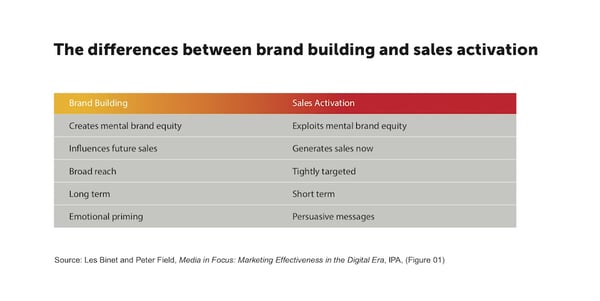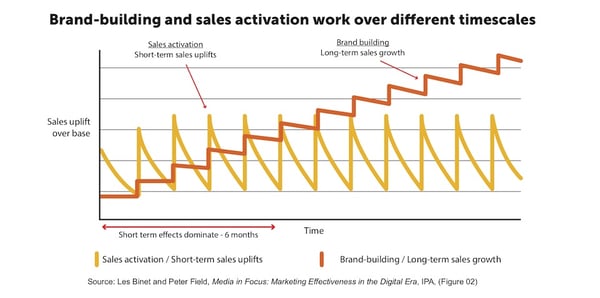
Brand Building for the Trillion-Dollar E-Commerce Industry
"A key trend we are seeing for e-commerce is investment in brand building. You can’t just keep driving direct response, but need to also put effort into brand favorability." - Nicolas Franchet, Director of Global Vertical Strategy for Facebook, during a talk on "Unlocking Regional & Vertical Growth" at Facebook's 2018 Partner Summit in New York City
Things are continuing to heat up for the e-commerce space. In 2017, retail e-commerce sales worldwide amounted to 2.3 trillion US dollars and revenues are projected to grow to 4.88 trillion US dollars in 2021, according to recent figures from Statista.
In this crowded space, ongoing sales, discounts, and coupon codes are plentiful. So how can e-commerce players stand out from the crowd and drive sales, while avoiding price wars and paper thin margins?
The evolution of the e-commerce industry
Increasingly, e-commerce companies are starting to realize the importance of branding. The first wave of e-commerce companies such as Amazon, eBay, and AliExpress focused primarily on offering variety and discounted prices, relying on scale to achieve meaningful margins. With this sort of focus, e-commerce advertising has typically been focused solely on direct response - driving customer acquisition and sales conversions.
For a long time, e-commerce companies didn't have to think of brand building. But in the last decade, things have become more competitive. Established brick-and-mortar retailers with strong brands have set up their own digital storefronts, and smaller, regional players have entered the scene. E-commerce companies are starting to realize that they need to compete for customers' attention. And increasingly, this competition is happening within an extremely small piece of digital real estate - the mobile phone.
Mobile marketing requires more precision in targeting
As of 2018, mobile accounted for around 63.5% of total e-commerce sales. By 2021, it will hit 72.9%, according to eMarketer. The limited screen space means less space to showcase a wide range of products. This has two implications: first, advertising has to get a whole lot more targeted and personalized in order to show the most relevant product to each individual customer.
“Mobile forces you to use every piece of data that you have available to you to get it right and really show our users, their friends, your customers, the products that they’re most likely to be interested in,” said Facebook's Nicolas Franchet. “And you can draw from lots of data, who they are, where they live, who they know, etc. It’s a very exciting element of targeting.”
Low switching costs requires e-commerce platforms to become more distinctive
Secondly, variety and price alone can no longer be the only differentiating factor to attract customers. Even setting aside the limitations of mobile screen space, customers today are accustomed to comparing prices between sites and scouring the web for additional coupon codes before they make their final purchase. Very often, they are agnostic about the marketplace from which they make their final purchase.
For these reasons, more and more e-commerce players are realizing the importance of branding. Whether they are known for their values (Threadless - supporting the artistic community and giving artists a platform) or their excellent customer service (Zappos.com - branded as a "customer service company that sells shoes"), e-commerce platforms are realizing that what keeps customers coming back is a distinguishable brand.
The good news is, even in a crowded space where distractions abound, it takes as little as 0.25 seconds for viewers to recall an ad they saw in their feed, according to Facebook.
Branding goes hand-in-hand with direct response
Branding and awareness campaigns do not have to compete with direct response campaigns. As marketing thought leaders Les Binet and Peter Field have pointed out in their famous comparison charts, brand building is a long term strategy to create mental brand equity. Sales activation, or what is more commonly called "direct response" today, is short term and tactical, exploiting the mental brand equity that has already been built up. Both are necessary to sustain sales in the long-term.

In addition, brand building and sales activation (direct response) work over different timescales. Sales activation may drive short-term sales uplifts, but needs continuous investment to drive results and the results do not increase with time, but with budget. Brand building is designed for long-term sales growth, and over time, investment into brand building has a compounding effect, with increasing results over a longer period of time.

As Seth Godin, marketer and best-selling author puts it:
"The reason it seems that price is all your customers care about is that you haven't given them anything else to care about."
More and more e-commerce companies are starting to realize this and embrace branding, paying more attention to not just driving click-throughs and looking at CPC and CPA, but also how people are reacting to their messaging and brand.
This new wave of e-commerce marketing is set to build stronger connections between businesses and customers, while enlarging the pie for the entire industry as value becomes tied not just to price, but other brand attributes as well.
Agree or disagree? Have you seen any e-commerce branding ads that have made an impact on you? Let us know what you think in the comments below!